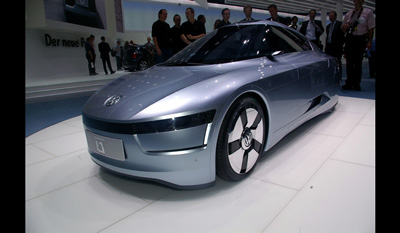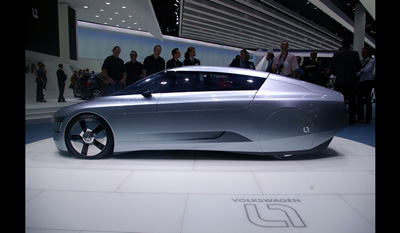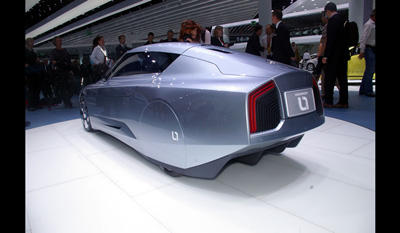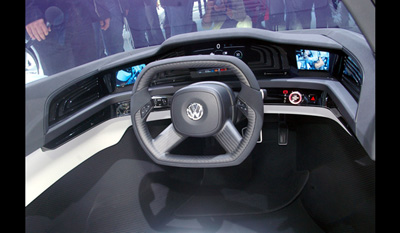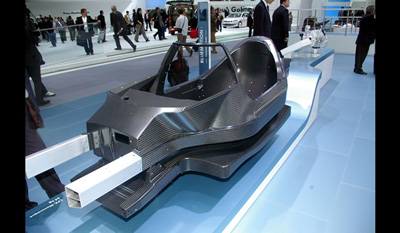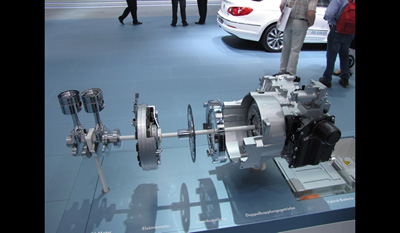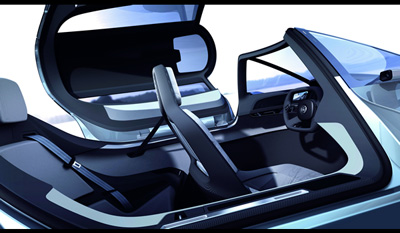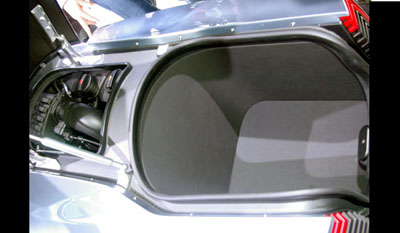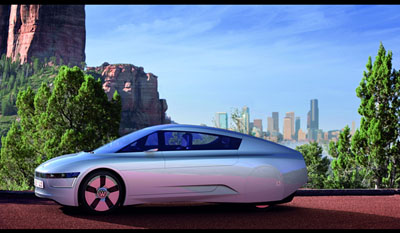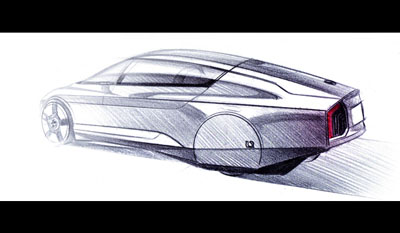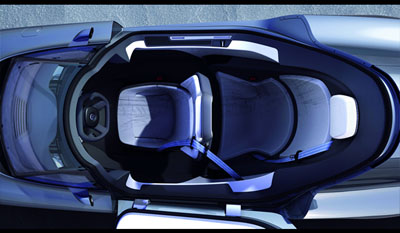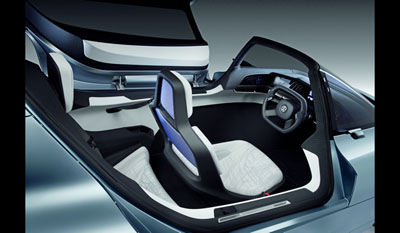Volkswagen L1 Diesel Hybrid Concept 2009 intended for production in 2013
At the 2009 IAA Frankfort Motor Show, Volkswagen presented the L1 Concept that points the way toward the production version announced for 2013.The full hybrid tandem two seats vehicle weighs just 380 kg thanks to its carbon-fibre reinforced body (CFRB). With a combined fuel consumption figure of 1,38 litres of diesel per 100 kilometres, this extremely aerodynamic (Cd 0,195) Volkswagen suitable for everyday use is intended to become the most fuel-efficient automobile in the world. CO2 emissions of the 160 kph L1 are similarly low at 36 g/km. Maximum speed is announced for 160 kph. Seven years ago, Dr. Ferdinand Piëch, at the time Chairman of the Board of Management and today Chairman of the Supervisory Board of the Volkswagen Group, drove a prototype from Wolfsburg to Hamburg that was unlike any other car before it: The Volkswagen 1 Litre car- the world's first car with fuel consumption of one litre per 100 kilometres. See Car Reviews - Volkswagen 1 Litre concept 2002 for further details and pictures. The man and machine and machine wrote automobile history. In April 2002, however, it was also clear that the time for a production version of the 1 Litre car lay far in the future. Production of the body itself - from carbon-fibre reinforced plastic (CRFP) - was not realistic due to cost considerations. Yet, in 2002 Dr. Ferdinand Piëch already announced that the time would soon come for the 1-Litre car and CFRP as a material for industrial applications. By 2009 the time had come: Volkswagen is making a clear statement at the IAA in Frankfort with the second generation of this ingenious car: the L1 represents a step forward into the future with completely new technology and a new design: revolutionary yet close to production readiness. "It is an enormous challenge to control costs in producing the monocoque out of CFRP," says Dr. Ulrich Hackenberg, member of the Board of Management for the Volkswagen brand with responsibility for development. Both technically and visually, the CFRP body is already considered a significant achievement in car design. Unique on this car are the proportions of its dimensions. While the length of the L1 at 3.813 millimetres is stil similar to that of a Volkswagen Fox, and its height of 1.143 millimetres nearly matches that of a Lamborghini Murciélago, the car's aerodynamically optimized width (1.200 millimetres) has no comparisons in the world of today's production cars.
In developing this car, the key starting point was body construction, and a core question was raised: How would a car have to look and be built to consume as little energy as possible, The logical answer includes extremely aerodynamic and lightweight, with a non negotiable condition of a maximum of safety. The selected approach is a narrow two-seater with a CFRP body. This dictated the seating layout in tandem, one seat behind the other. The dry weight of the L1 is just 380 kg, of which 122 kg are taken by the drivetrain, 79 kg by the chassis, 35 kg by interior furnishing and 20 kg by the electrical system. 124 kg remains for the body. These 124 kg can be further broken down to 64 kg for the CFRP monocoque including integrated passenger seat (see slide N°7/33 and 8/33), 28 kg for the entire CFRP exterior skin, 19 kg for the CFRP entry canopy, 9 kg for the CFRP driver's seat and 4 kg for the LED lights. All instruments and controls are arranged over a 180 degree radius in front of the driver which places them perfectly within view and reach. The instrument panel itself has been integrated onto the CFRP monocoque. To start the L1, the driver pushes a button on the right side of the steering wheel. When it is rotated, the round start button simultaneously serves as a gear selector switch and is used to activate the electronic handbrake. The entry canopy and rear hatch are operated electrically by touch controls to the left and right of the driver. Also designed as touch sensors are controls for the entire air conditioning control system. Via multifunctional keys in the steering wheel, the driver controls the on-board computer, navigation and entertainment systems. The classic door mirror and rear-view mirror have been completely eliminated and replaced by cameras display images on an organic light emitting diode displays on the instrument panel. (see slide N°10/33). In the case of a crash, not only are the driver and passenger protected by the monocoque, which is designed as a highly rigid CFRP safety cell, as well as aluminium crash elements in the front of the car. There is also a steering wheel airbag and head/side curtain airbags to the left and right inside the entry canopy. The powertrain consists of a two cylinder TDI 800 cc turbo-diesel engine with common rail direct injection, and electric motor and a seven-speed Direct Shift Gearbox. ( see slide N°11/33 and 12/33). It is operated in two different modes depending on the load conditions. In the standard "ECO" mode, the 800 cc TDI develops a power of 20 kW/27 hp at 4.000 rpm; in "Sport" mode - used to reach top speed, for example- the car power rises to 29 kW/39 hp at 4.000 rpm. The TDI maximum torque is 100 Nm at 1.900 rpm. The L1 is equipped with start/stop system that automatically shuts down the engine when the vehicle is stopped and restarts when accelerator is actuated. The powertrain is mounted in front of the rear axle. A small luggage space has been implemented at the back and can be reached by the same hatch as for the engine (see slideshow image n°33/33).
The hybrid module has been integrated into tha housing of the seven-speed DSG ( Direct Shift Gearbox). It is located between the TDI engine and the DSG gearbox and consists of a 10 kW/14 hp electric motor and a clutch. The electric motor is supplied with energy from a lithium-ion battery located at the front of the car. An electronic power control module operating at around 130 Volts manages the flow of high voltage energy from the battery and to the electric motor. In normal operation the electric motor can support the TDI engine in conditions such as by electronic load point shifting and in acceleration. If necessary- generally during acceleration - the electric motor can supply 40 percent additional torque over the entire engine speed range. Moreover, the electric motor can propel the L1 over short distances by itself. In this case an auxiliary clutch disengages the TDI engine from the drivetrain. In braking phases, the electric motor operates as a generator to charge the lithium-ion battery by recovering braking energy. Texte Paul Damiens - Photos and rendering illustrations Volkswagen and Paul Damiens
VolksWagen L1 Hybrid Concept 2009 wallpapers (click on the picture to enlarge)
Related Articles :
|
|||||||||||||||||||||||||||||||||||||||||||||
|---|---|---|---|---|---|---|---|---|---|---|---|---|---|---|---|---|---|---|---|---|---|---|---|---|---|---|---|---|---|---|---|---|---|---|---|---|---|---|---|---|---|---|---|---|---|
|
||||||||||||||








